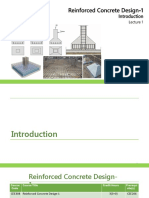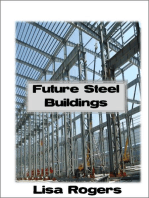0 ratings0% found this document useful (0 votes)
59 viewsPlain & Reinforced Concrete - II: Lesson No 02: Design Methodology Dr. Musaad Zaheer Nazir Khan
This document provides an overview of the design methodology for reinforced concrete structures. It discusses that structures must be both safe and serviceable. It then describes the principal structural materials used in construction, including ordinary reinforced concrete, prestressed concrete, structural steel, composite construction, timber and masonry. For reinforced concrete, it discusses the fundamental assumptions in design and notes that design is based on the inelastic behavior of concrete and steel at failure. It also discusses design codes commonly used like the International Building Code, ACI-318, and AASHTO specifications.
Uploaded by
Muhammad Salman JavaidCopyright
© © All Rights Reserved
Available Formats
Download as PPTX, PDF, TXT or read online on Scribd
0 ratings0% found this document useful (0 votes)
59 viewsPlain & Reinforced Concrete - II: Lesson No 02: Design Methodology Dr. Musaad Zaheer Nazir Khan
This document provides an overview of the design methodology for reinforced concrete structures. It discusses that structures must be both safe and serviceable. It then describes the principal structural materials used in construction, including ordinary reinforced concrete, prestressed concrete, structural steel, composite construction, timber and masonry. For reinforced concrete, it discusses the fundamental assumptions in design and notes that design is based on the inelastic behavior of concrete and steel at failure. It also discusses design codes commonly used like the International Building Code, ACI-318, and AASHTO specifications.
Uploaded by
Muhammad Salman JavaidCopyright
© © All Rights Reserved
Available Formats
Download as PPTX, PDF, TXT or read online on Scribd
You are on page 1/ 20
Plain & reinforced concrete - II
Lesson no 02: Design Methodology
Dr. Musaad Zaheer Nazir Khan
Structural Safety and Serviceability
• A structure must be safe against collapse and serviceable to use
• Safety requires that the strength of the structure be adequate for all loads that may
foreseeably act on it.
• Serviceability requires that deflections be adequately small; that cracks, if any, be
kept to tolerable limits; that vibrations be minimized
• If the strength of a structure, built as designed, could be predicted accurately, and if
the loads and their internal effects (moments, shears, axial forces) were known
accurately, safety could be ensured by providing a carrying capacity just barely in
excess of the known loads.
Structural Materials
• Following are the principle structural materials available which
are used in the construction.
1. Ordinary Reinforced Concrete
2. Prestressed Concrete
3. Structural Steel
4. Composite Construction
5. Timber
6. Masonry
Structural Materials
• Factors affecting choice of structural material.
1. Strength
2. Durability
3. Architectural Requirements
4. Versatility
5. Safety
6. Speed of Construction
7. Maintenance
8. Cost
Structural Materials
Why Reinforced Concrete ?
Reinforced Concrete
• Fundamental assumptions in the design of reinforced
concrete
• Internal forces at any section of the member are in equilibrium
• The strain in the embedded reinforced bar is the same as that of the
• surrounding concrete
• Plane cross-sections continue to be plane in the member under
load.
• Concrete is not capable of resisting any tensile stresses
Basis of Design
• Actual strength of the structure must be large enough to resist foreseeable loads during its life
(with some margin to spare) without failure or other distress
• Select concrete dimensions (proportion members) and reinforcement, so that member
strengths are adequate to resist forces, significantly above loads expected actually to occur in
service.
• This design concept is known as strength design.
Basis of Design
• For reinforced concrete structures close to and at failure, one or both of the materials,
concrete and steel, are invariably in their nonlinear inelastic range.
• Concrete in a structural member reaches its maximum strength and subsequent fracture at
stresses and strains far beyond the initial elastic range.
• Steel close to and at failure of the member is usually stressed beyond its elastic domain
into and even beyond the yield region.
• Consequently, the nominal strength of a member must be calculated on the basis of this
inelastic behavior of the materials.
• A member designed by the strength method must also perform in a satisfactory way
under normal service loading.
– Beam deflections must be limited to acceptable values,
– Flexural cracks at service loads must be controlled.
Basis of Design
• In earlier method, members were proportioned so that stresses in the steel and concrete
under service loads remain within specified limits. Known as allowable stresses, were
only fractions of the failure stresses of the materials.
• It is now referred as service load design.
• Allowable stresses, in practice, were set at about one-half the concrete compressive
strength and one-half the yield stress of the steel.
• Because of the difference in realism and reliability, the strength design method has
displaced the service load design method.
• However, the older method provides the basis for some serviceability checks and is the
design basis for many older structures.
• Strength design is used for design almost exclusively these days.
Design Codes used
• The design of concrete structures is generally done within the framework of codes giving
specific requirements for materials, structural analysis, member proportioning.
• International Building Code (IBC) is an example of a consensus code governing structural
design
• American Concrete Institute - Building Code Requirements for Structural Concrete and
Commentary (ACI–318) serves as a guide in the design and construction of reinforced
concrete buildings.
• Incorporated into the IBC, ACI–318 an authoritative statement of current good practice in
the field of reinforced concrete.
• Most highway bridges in the United States are designed according to the requirements of
the AASHTO bridge specifications
• The design of railway bridges is done according to the specifications of the AREMA
Manual of Railway Engineering
You might also like
- Dimensions, Weights and Properties of Special and Standard Structural Steel Shapes Manufactured by Bethlehem Steel CompanyFrom EverandDimensions, Weights and Properties of Special and Standard Structural Steel Shapes Manufactured by Bethlehem Steel CompanyNo ratings yet
- The Essentials of Material Science and Technology for EngineersFrom EverandThe Essentials of Material Science and Technology for Engineers5/5 (1)
- CIQA PQ Template Protocol Lyophilization Process Sample Version100% (2)CIQA PQ Template Protocol Lyophilization Process Sample Version3 pages
- CE 4347 Reinforced Concrete Design: Handout 1-IntroductionNo ratings yetCE 4347 Reinforced Concrete Design: Handout 1-Introduction17 pages
- 054 1 541 Mechanics and Design of ConcreNo ratings yet054 1 541 Mechanics and Design of Concre7 pages
- structural_design_study_material_compressed_1588418516No ratings yetstructural_design_study_material_compressed_158841851693 pages
- Advances in Structural Concrete: Association of Engineers, Gaza Governorates, PalestineNo ratings yetAdvances in Structural Concrete: Association of Engineers, Gaza Governorates, Palestine33 pages
- Chapter 1 - INTRODUCTION TO STRUCTURAL DESIGNo ratings yetChapter 1 - INTRODUCTION TO STRUCTURAL DESIG20 pages
- Introduction To RC Design: National Mission On Education Through Ict (MHRD, Govt of India)No ratings yetIntroduction To RC Design: National Mission On Education Through Ict (MHRD, Govt of India)22 pages
- Reinforced Concrete Structures R. Park T.paulayNo ratings yetReinforced Concrete Structures R. Park T.paulay783 pages
- Robert Park, Thomas Paulay-Reinforced Concrete Structures-Wiley (1975) PDFNo ratings yetRobert Park, Thomas Paulay-Reinforced Concrete Structures-Wiley (1975) PDF783 pages
- Reinforced Concrete Structures Park & PaulayNo ratings yetReinforced Concrete Structures Park & Paulay783 pages
- Reinforced Concrete Structures by R. Park & T.Paulay - 1974 WILEY PDF100% (1)Reinforced Concrete Structures by R. Park & T.Paulay - 1974 WILEY PDF783 pages
- Beam Design Methods and Requirements 4.1 Aci Building CodeNo ratings yetBeam Design Methods and Requirements 4.1 Aci Building Code7 pages
- CE 315: Design of Concrete Structures I: EmailNo ratings yetCE 315: Design of Concrete Structures I: Email44 pages
- Reinforced Concrete Design by Professor Anthony Kwame DansoNo ratings yetReinforced Concrete Design by Professor Anthony Kwame Danso131 pages
- Objectives and Methods of Analysis and Design100% (5)Objectives and Methods of Analysis and Design965 pages
- Hand Book For Steel Structure Quality Control on SiteFrom EverandHand Book For Steel Structure Quality Control on SiteNo ratings yet
- Plain & Reinforced Concrete - II: Lecture ZeroNo ratings yetPlain & Reinforced Concrete - II: Lecture Zero7 pages
- Plain & Reinforced Concrete - Ii: Lesson No 01No ratings yetPlain & Reinforced Concrete - Ii: Lesson No 0134 pages
- Physics and Chemestry Bimestre 1 Marzo 09No ratings yetPhysics and Chemestry Bimestre 1 Marzo 094 pages
- Simultaneous Sorting of Wavelengths and Spatial Modes Using Multi-Plane Light ConversionNo ratings yetSimultaneous Sorting of Wavelengths and Spatial Modes Using Multi-Plane Light Conversion6 pages
- City Life and Garbage Disposal in Kochi-Challenges and OpportunitiesNo ratings yetCity Life and Garbage Disposal in Kochi-Challenges and Opportunities16 pages
- 2024-05-30 Monoammonium Phosphate Process Line Costing InformationNo ratings yet2024-05-30 Monoammonium Phosphate Process Line Costing Information7 pages
- Jurnal IMPLEMENTASI STRATEGI PENANGANAN KAWASAN PERMUKIMAN KUMUH DI KELURAHAN KEMANG AGUNG KECAMATAN KERTAPATI KOTA PALEMBANGNo ratings yetJurnal IMPLEMENTASI STRATEGI PENANGANAN KAWASAN PERMUKIMAN KUMUH DI KELURAHAN KEMANG AGUNG KECAMATAN KERTAPATI KOTA PALEMBANG16 pages
- Cambridge Latin Course Unit 3: Quarter 2: Stage 23: Date Homework Due Lesson Homework All Roads Lead To RomeNo ratings yetCambridge Latin Course Unit 3: Quarter 2: Stage 23: Date Homework Due Lesson Homework All Roads Lead To Rome2 pages
- Managerial Accounting 16th Edition Garrison Solutions Manual - 2025 Version Is Available With All Chapters100% (7)Managerial Accounting 16th Edition Garrison Solutions Manual - 2025 Version Is Available With All Chapters55 pages
- Instant ebooks textbook CRISPR and Plant Functional Genomics 1st Edition Jen-Tsung Chen download all chapters100% (1)Instant ebooks textbook CRISPR and Plant Functional Genomics 1st Edition Jen-Tsung Chen download all chapters55 pages
- Reinforced Concrete Buildings: Behavior and DesignFrom EverandReinforced Concrete Buildings: Behavior and Design
- Dimensions, Weights and Properties of Special and Standard Structural Steel Shapes Manufactured by Bethlehem Steel CompanyFrom EverandDimensions, Weights and Properties of Special and Standard Structural Steel Shapes Manufactured by Bethlehem Steel Company
- The Essentials of Material Science and Technology for EngineersFrom EverandThe Essentials of Material Science and Technology for Engineers
- CIQA PQ Template Protocol Lyophilization Process Sample VersionCIQA PQ Template Protocol Lyophilization Process Sample Version
- CE 4347 Reinforced Concrete Design: Handout 1-IntroductionCE 4347 Reinforced Concrete Design: Handout 1-Introduction
- structural_design_study_material_compressed_1588418516structural_design_study_material_compressed_1588418516
- Advances in Structural Concrete: Association of Engineers, Gaza Governorates, PalestineAdvances in Structural Concrete: Association of Engineers, Gaza Governorates, Palestine
- Introduction To RC Design: National Mission On Education Through Ict (MHRD, Govt of India)Introduction To RC Design: National Mission On Education Through Ict (MHRD, Govt of India)
- Robert Park, Thomas Paulay-Reinforced Concrete Structures-Wiley (1975) PDFRobert Park, Thomas Paulay-Reinforced Concrete Structures-Wiley (1975) PDF
- Reinforced Concrete Structures by R. Park & T.Paulay - 1974 WILEY PDFReinforced Concrete Structures by R. Park & T.Paulay - 1974 WILEY PDF
- Beam Design Methods and Requirements 4.1 Aci Building CodeBeam Design Methods and Requirements 4.1 Aci Building Code
- Reinforced Concrete Design by Professor Anthony Kwame DansoReinforced Concrete Design by Professor Anthony Kwame Danso
- Hand Book For Steel Structure Quality Control on SiteFrom EverandHand Book For Steel Structure Quality Control on Site
- Introduction to Design of Building StructuresFrom EverandIntroduction to Design of Building Structures
- Simultaneous Sorting of Wavelengths and Spatial Modes Using Multi-Plane Light ConversionSimultaneous Sorting of Wavelengths and Spatial Modes Using Multi-Plane Light Conversion
- City Life and Garbage Disposal in Kochi-Challenges and OpportunitiesCity Life and Garbage Disposal in Kochi-Challenges and Opportunities
- 2024-05-30 Monoammonium Phosphate Process Line Costing Information2024-05-30 Monoammonium Phosphate Process Line Costing Information
- Jurnal IMPLEMENTASI STRATEGI PENANGANAN KAWASAN PERMUKIMAN KUMUH DI KELURAHAN KEMANG AGUNG KECAMATAN KERTAPATI KOTA PALEMBANGJurnal IMPLEMENTASI STRATEGI PENANGANAN KAWASAN PERMUKIMAN KUMUH DI KELURAHAN KEMANG AGUNG KECAMATAN KERTAPATI KOTA PALEMBANG
- Cambridge Latin Course Unit 3: Quarter 2: Stage 23: Date Homework Due Lesson Homework All Roads Lead To RomeCambridge Latin Course Unit 3: Quarter 2: Stage 23: Date Homework Due Lesson Homework All Roads Lead To Rome
- Managerial Accounting 16th Edition Garrison Solutions Manual - 2025 Version Is Available With All ChaptersManagerial Accounting 16th Edition Garrison Solutions Manual - 2025 Version Is Available With All Chapters
- Instant ebooks textbook CRISPR and Plant Functional Genomics 1st Edition Jen-Tsung Chen download all chaptersInstant ebooks textbook CRISPR and Plant Functional Genomics 1st Edition Jen-Tsung Chen download all chapters






























































































